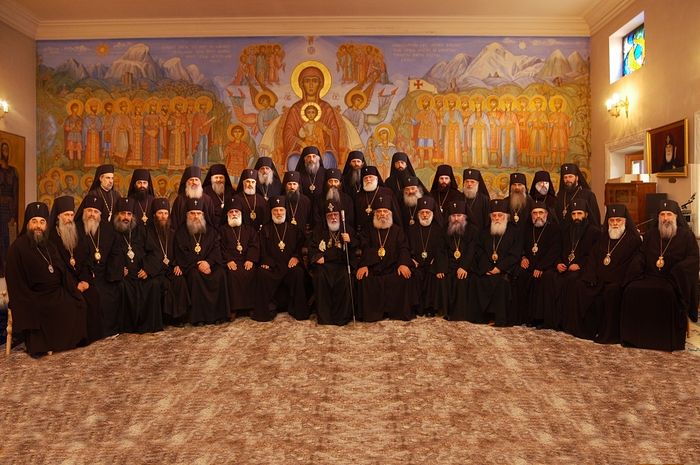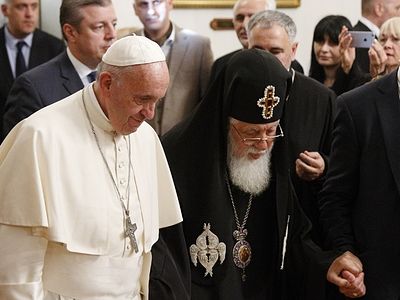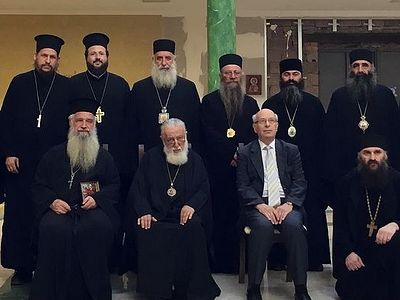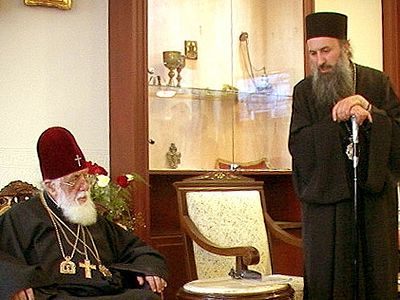Source: Orthodox Ethos
November 24, 2016
INTRODUCTION
Among the milestones of contemporary Orthodox ecclesiastical history with regard to the Church's struggle to maintain "the faith once delivered" and Her belief in the "One, Holy, Catholic and Apostolic Church," the 1998 Synodical Decision of the Apostolic Orthodox Church of Georgia is of especial importance. Echoing the earlier decision of the Russian Orthodox Church Outside of Russia in 1983, which condemned the heresy of ecumenism, and in particular made reference to the "Branch Theory," the Decision of the Apostolic Orthodox Church of Georgia is broader in scope, touching on six different manifestations of unorthodox teachings emanating from the contemporary ecumenical movement and ecumenical involvement of the Local Orthodox Churches.
In particular, the decision rejects by name the Chambésy and Balamand agreements, the agreement signed by the Patriarch of Antioch with the Non-Chalcedonians in Syria, in 1991, the adoption of the Gregorian Paschalion by the Finnish Church under the Ecumenical Patriarchate, the idea that the Holy Mysteries exist outside the Church and also the various manifestations of the "Branch Theory," as well as common prayer and sharing of mysteries with the non-Orthodox. Both the particular and wide-ranging nature of the decision increases its importance and significance for the entire Church in terms of coming to a pan-Orthodox consensus with regard to the heretical nature of syncretistic ecumenism. For this reason, the fact that it has (to our knowledge) never been translated into English - until now - is all the more astounding.
It is important to note the following concerning this Synodical Decision, so as to put it into its proper historical and ecclesiastical context:
The Holy Synod's decision was based on a review done by a theological commission appointed by the Catholicos-Patriarch of Georgia, Ilia II. The decision to create the commission and review the above-mentioned six issues and texts came on the heel of a major, popular "uprising" of the faithful of Georgia, in particular, the monastic community. Hence, it was the watchfulness and dogmatic sensitivity, not only or even primarily of the hierarchy, but of the entire pleroma of the faithful that brought about this landmark decision in favor of Orthodox ecclesiology. This point cannot be over-stated and must be seriously considered by the faithful everywhere, in every Local Church, for every believer is co-responsible for the guarding of the deposit of the Faith and the upbuilding of the Church.
Finally, it is also necessary to stress that the process by which the Church will eventually purify itself of heretical notions and teachings, such as are promoted within syncretistic ecumenism, is a primarily local phenomenon. As matters stand in contemporary Orthodoxy, one Local Church at a time - clergy and laymen - must examine and reject the cacodoxies preached and promoted within syncretistic ecumenist circles before one can expect that the Orthodox Catholic Church of Christ will finally issue a definitive ruling in a universal council. This is why this decision by the Church of Georgia is a milestone and has held great promise for the Church. This process of confronting the ecumenist provocations and formulating the Orthodox faith in the One, Indivisible and Catholic Church, over and against the innovative, syncretistic ecumenistic ecclesiology, was re-started in earnest with this 1998 ruling of the Georgian Church (even if largely unknown to most Orthodox) and has continued as of late, pre and post-Crete, in both the Georgian and Bulgarian Orthodox Synods, with the latter rejecting the "Council" of Crete in particular because of its ecumenist ecclesiological posture. Given this historic 1998 decision of the Church of Georgia, perhaps the clearest and most wide-ranging synodical decision ever issued against syncretistic ecumenism, we can expect that the Holy Synod of the Church of Georgia will soon follow suit and reject the "Council" of Crete.
May this decision by the Church of Georgia finally receive the proper attention it deserves by the hierarchy and faithful of all the Local Orthodox Churches, inspiring them to follow suite and declare with clarity the Orthodox faith in the One, Holy, Catholic and Apostolic Church, over and against the ecclesiology of syncretistic ecumenism unfortunately acquitted and given life by the "Council" in Crete.
- Protopresbyter Peter Heers, Author of The Ecclesiological Renovation of Vatican II: An Orthodox Examination of Rome’s Ecumenical Theology Regarding Baptism and the Church
THE DECISION:
October 8, 1998
The Minutes of the Meeting of the Holy Synod
The session of Holy Synod of Georgian Orthodox Church was held in the conference hall of the residence of the Patriarchate of Georgia on the 8th of October, 1998. Twenty-four hierarchs (a full complement) of the Georgian Orthodox Church participated in the session.
His Beatitude and Holiness, the Catholicos-Patriarch of All Georgia, Ilia II acted as the chairman of the session. The bishop of the Poti Eparchy, Grigol (Berbichashvili) was appointed secretary of the session.
The Holy Synod received the information provided by the Theological Commission which had been created with blessing of the Catholicos-Patriarch of All Georgia, Ilia II, in July of 1997. The commission examined those issues which had become the reason for scandal for some members of the Church.
The Theological Commission examined the following documents and issues: the so-called Chambésy and Balamand documents, the project for the agreement between the Orthodox Church of Antioch and Non-Chalcedonian (Oriental) churches, worked out in 1991, the celebration of Pascha by the Finnish Orthodox Church according to the Gregorian Paschalion, the teaching about the existence of saving grace beyond the limits of the Church's canonical boundaries, as well as the so-called “Branch Theory.”
The Theological Commission contacted the Constantinopolitan, Antiochian and Russian Patriarchates and also inquired concerning the positions of different Churches with regard to the above-mentioned issues.
It should be emphasized that a number of Autocephalous Churches, with the Georgian Church among them, had never made a definitive decision by means of a general gathering, regarding the above-mentioned issues. Moreover, some of the Churches have indeed evaluated them negatively, with a special decision by the Holy Synod.
As these issues serve as the ground for doubt on the part of our believers, the Theological Commission of the Patriarchate of Georgia examined the relevant materials and published its conclusions in 3 issues of Information Bulletins.
The Holy Synod of the Georgian Orthodox Church became acquainted and agreed with the conclusions of the Georgian Patriarchate's Theological Commission. The position delineated below is the religious worldview of the Georgian Orthodox Church, which has always shared it.
This position is declared and distinctly stated again, as follows:
The Holy Synod of the Georgian Orthodox Church has decreed:
1. The documents of the Theological Commission of the Joint Theological Dialogue between the Orthodox Church and Non-Chalcedonian (oriental) churches (the so-called Chambésy agreements) held in 1990 and 1993 in Chambésy (Switzerland), are unacceptable.
2. The project for the preliminary agreement between the Orthodox Church of Antioch and Non-Chalcedonian (oriental) churches, worked out in 1991, is unacceptable.
3. The document: “Uniatism as a method of union of the past, and the present search for full communion” (the so-called “Balamand Agreement”), accepted by the Joint Commission of the Catholic Church and the Orthodox Church in Balamand (Lebanon), in June 23, 1993, is unacceptable.
4. The celebration of Pascha by the Finnish Autonomous Church according to the Gregorian Paschalion does not comply with the resolution of the First Ecumenical Council of Nicaea with regard to the date for celebrating Pascha. However, it must be stated that, on the assumption of the general Orthodox position, this fact was considered as a Canonical violation, not as heresy.
Thus, in this regard, it is important that the Patriarchate of Constantinople (the jurisdiction of which includes the Finnish Autonomous Church) is negatively disposed to the above-mentioned canonical violation and considers that Pascha must be celebrated according to the resolution of the First Ecumenical Council of Nicaea (See letter # 1214/1997 of Patriarch of Constantinople).
5. The heretical ecclesiological teaching, which was created in the depths of non-Orthodox, modernistic theology, concerning the existence of saving bliss [mysteriological grace] beyond the canonical limits of the Church, and its extreme manifestation – the so-called “Branch Theory,” according to which the various Christian branches in existence today are considered as different and equal branches of the True Church of Christ – is unacceptable.
6. Finally, both praying together with, and receiving the Mysteries with, non-Orthodox people is unacceptable, as was confirmed once again in the final text accepted by the Assembly of all the Canonical Orthodox Churches (Thessaloniki, Greece, April 29 – May 2, 1998). According to article #13, paragraph B of this document: “Orthodox delegates will not participate in ecumenical services, common prayer and the worship of God, and in other religious ceremonies of the assembly."
An extensive analysis of the aforementioned issues is given in information bulletins (#1, #2, #3) of the Theological Commission of the Patriarchate of Georgia.





